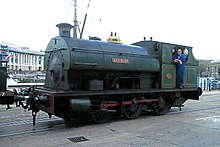
Peckett and Sons was a locomotive manufacturer at the Atlas Locomotive Works on Deep Pit Road between Fishponds and St. George, Bristol, England.
Fox, Walker and Company

The company began trading in 1864 at the Atlas Engine Works, St. George, Bristol, as Fox, Walker and Company, building four and six-coupled saddle tank engines for industrial use. They also built stationary engines and pioneered steam tramcars, the first being tested in Bristol in 1877.
Much of their output was exported, mostly 0-6-0, with some 0-4-0, 2-4-0 and 0-4-2. In 1878 they produced six 18 in (457 mm) gauge 2-4-2 trench engines for the Royal Engineers at Chatham using Henry Handyside's steep gradient apparatus. They also produced nine 0-6-0STs for the Somerset and Dorset Railway.
Peckett and Sons

They were taken over by Thomas Peckett in 1880, becoming Peckett and Sons, Atlas Engine Works, Bristol. The company acquired limited liability some years later. By 1900 the two companies had built over 400 locomotives.
The company continued producing a variety of small industrial and shunting engines at their factory located between Fishponds and Kingswood in Bristol. They became specialists in the field, with very precise specifications and standardisation of parts. The largest engine was an 0-8-0 built in 1931 for the Christmas Island Phosphate Company. The works were served by a branch line starting just south west of Kingswood junction on the Midland line and ran for about 1 mile (1.6 km) in a generally eastward direction. It also served some collieries in the Speedwell area. The only evidence remaining of this line is a bridge abutment on Whitefield Road.
During the two World Wars, the works were especially busy, but by 1950 trade had largely dried up. Although in 1956 an attempt had been made to enter the diesel-mechanical market, the last steam engine was produced in 1958 and the company was taken over by Reed Crane & Hoist Co Ltd on 23 October 1961, which itself later went into liquidation.
Production and preservation
Further information: List of Peckett and Sons railway locomotivesDespite hard work and poor maintenance, the engines were long-lasting. Many Peckett locomotives survive working on today's heritage railways around the world.
- The last Peckett steam locomotive built, 2165 of 1958, is preserved at Sandstone Estates, South Africa
- The oldest surviving Fox Walker locomotive is "Karlskoga", an 0-6-0ST of 1873 and the first locomotive of the Nora Bergslags Railway [sv] in Sweden. It was steamed at Nora, Sweden in 1982.
References
- ^ "Records of Peckett & Sons Limited, Locomotive Manufacturers, Bristol" (PDF). National Railway Museum. Archived from the original (PDF) on 4 October 2012. Retrieved 19 December 2015.
- "Thomas Peckett & Sons, photographs of newly completed locomotives". National Archives. Retrieved 19 December 2015.
- "Peckett and Sons". Grace's Guide to British Industrial History. Retrieved 19 December 2015.
- "Peckett & Sons Ltd / Fox Walker & Co". Buckinghamshire Railway Centre. Archived from the original on 22 December 2015. Retrieved 19 December 2015.
- ^ Lee, M. J. "A Brief Memoir". Industrial Railway Record. Retrieved 19 December 2015.
- "NKJ 1 "Karlskoga"". Nora Bergslags Veteran Railway Association (in Swedish). Archived from the original on 4 March 2016. Retrieved 20 December 2015.
- Lowe, J.W., (1989) British Steam Locomotive Builders, Guild Publishing
External links
- The industrial railway Record, A brief memoir of Peckett & Sons LTD
- Peckett's in Retrospect
- Gloucestershire LXXII.SW, Revised: 1938, Published: ca. 1945, OS 6-inch maps showing Atlas Locomotive Works
- Peckett & Sons Archive, National Railway Museum
51°28′13.24″N 2°32′28.9″W / 51.4703444°N 2.541361°W / 51.4703444; -2.541361
Categories: